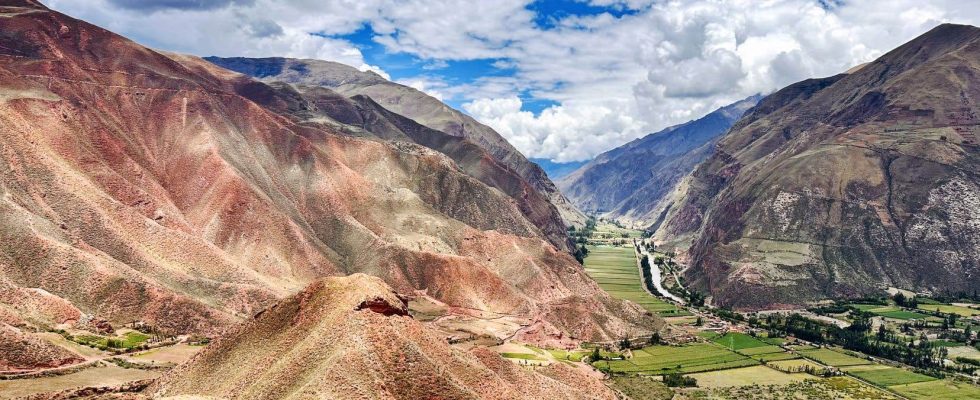This text is part of the special Pleasures notebook
Land of infinite wealth and archaeological treasures, the land of the Incas is still too often reduced to one of its greatest wonders. However, there are plenty of good reasons to venture off the beaten track to discover a Peru other than Machu Picchu, faced with the devastating effects of mass tourism.
Built in the heart of the 15th centurye century, under the reign of Emperor Pachacútec, the iconic citadel of the Peruvian Andes overcame many disasters, earthquakes and landslides. And this, thanks to the genius of the Incas who succeeded in interlocking blocks of granite weighing several tons with almost millimeter precision. There is, however, one thing that these outstanding architects, renowned for their famous terraced constructions blending harmoniously into their environment, clearly could not see coming.
A victim of its success since its discovery in 1911 by the spiritual father of Indiana Jones, Hiram Bingham, Machu Picchu is today threatened with erosion under the footsteps of tourists. More and more travelers are treading the old stones of the illustrious lost city. Damaged areas have already been closed to the public. And UNESCO has strongly sounded the alarm by brandishing the risk of seeing the seventh wonder of the modern world joining, in the near future, the sad list of world heritage properties in danger.
From one gem to another
In the meantime, small hands work daily to take care of the ancestral foundations of Machu Picchu, while mini-buses deliver an endless stream of tourists. The fascination that this high place of pilgrimage continues to exert among the general public can easily be understood. Especially since, beneath its spectacular attractions, the famous citadel still conceals some mysteries. It is said, among other things, that a bundle of gold is always hidden within its walls, under a burial chamber.
But Machu Picchu is far from being the only archaeological site to carry its share of myths and legends in the region. Considered the new jewel of the Sacred Valley of the Incas, Ollantaytambo owes its name to the leader of the armies who resisted Pachacútec for a forbidden love worthy of a Greek tragedy. Forced to go into exile for daring to fall in love with Princess Cusi Coyllor, daughter of the emperor, the fiery Captain Ollantay is said to have taken refuge in an impregnable fortress built by his devoted men.
Enigmatic stones
Arriving at the foot of the series of cut stone terraces, one cannot help but be captivated by the grandeur of this jewel of military architecture. The fortifications of Ollantaytambo are certainly among the most impressive that the Incas have left us. You have to climb a few hundred steps to get to the top of this stack of monoliths. The effort is worth it, to access the Temple of the Sun made up of six monumental porphyry blocks, one wonders how they got there (still a mystery).
From up there, the view of the valley crossed by the Urubamba River, which connects the Andes to the Amazon, is striking. Built more than 600 years ago, the old hamlet below seems very small. Its period houses with thick walls and narrow cobbled streets form one of the rare cities still inhabited by descendants of the Incas. Next to Aguas Caliente, gateway to Machu Picchu, the village of Ollantaytambo stands out for its carefully cultivated authenticity and much more controlled tourist development.
In the shadow of the “white giant”
When we go a little further off the beaten track, the countryside of Sagrado Valley offers us sumptuous natural landscapes, composed of flourishing cultures guarded by impressive celestial mountains touching the stars. The gigantic amphitheater of Moray, a former Inca agricultural laboratory, and the hanging pools of the Maras salt pans are certainly worth a look. But the picturesque villages that dot the region, known for its exceptional fertility, are just as worth taking the time to linger there.
In Urquillos, the word is worshiped as a deity. This white corn with giant ears reigns supreme in the fields and creates a feeling of pride among an entire community. It is in this bucolic setting, nestled at an altitude of more than 2900 meters, that the architect José Cruz Ovalle built the new hostel of the Explora group. This company is renowned for offering, in the most remote corners of South America, accommodation options allowing you to immerse yourself in the local culture, far from the nuisances of mass tourism.
With its sober and refined style, the hotel follows the curves of the surrounding relief like the remains of the terraces unearthed during its construction. This all-inclusive unlike any other is distinguished by its menu concocted by the great chef of Peruvian cuisine Virgilio Martinez, and by a copious choice of more than 30 guided adventures in the footsteps of the Chasquis, the legendary Inca messengers. A great opportunity to explore these sacred lands, outside the main traditional circuits.
For more information : www.peru.travel/fr
This content was produced by the Special Publications team at Duty, relating to marketing. The writing of the Duty did not take part.
